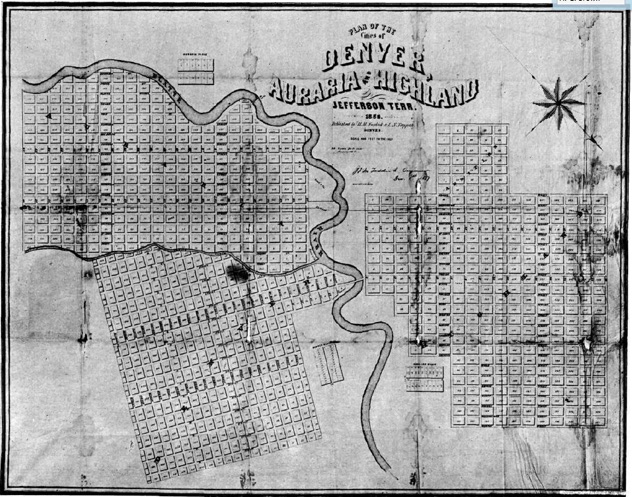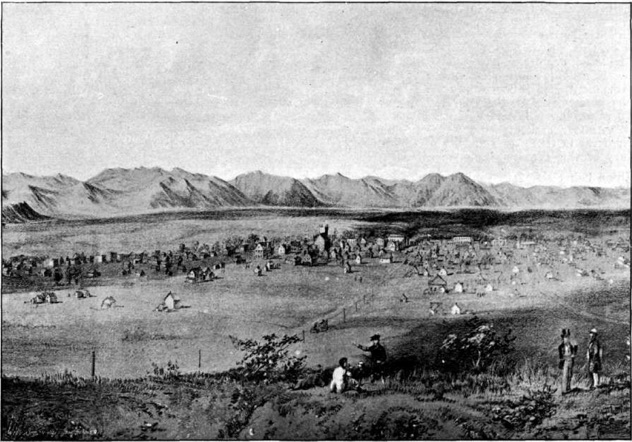

COLORADO HISTORY HAUNTS

The Paramount Apartment Building Story
The Intersection of 14th Avenue and Lincoln Street - Denver
WHAT Was REALLY There ? Before 1880
Gold, Greed, Guns and Gov’ment
HOW THE UNITED STATES DEVELOPED - QUICK OVERVIEW
COLORADO
Our best and brightest nurds tell us that the earliest people in Colorado were nomadic hunters who arrived some 12,000 to 20,000 years ago by way of the Bering Strait, following the tracks of the woolly mammoth and bison. Then, about 2,000 years ago, the people we call the Ancestral Puebloans arrived, living in shallow caves in the Four Corners area, where the borders of Colorado, Utah, Arizona, and New Mexico meet. Guess so.
In the 1820s as the West began to open up, the Santa Fe Trail was established, cutting through the southeast corner of what would later become Colorado. Much of eastern future-Colorado, including what would become Denver, Boulder and Colorado Springs, was then part of the Kansas Territory. It was populated almost exclusively by plains tribes until 1858, when gold-seekers discovered flakes of the precious metal near the junction of Cherry Creek and the South Platte. Here, the fourth city claim in this area was made pretty much on top of one that already existed. This claim was named for James Denver, then the Governor of the Kansas Territory. Denver City was claimed and named for him after he "provided the machinery for the civil organization of Arapahoe County, at the time when the town site was laid out. (more on this story; How Denver Got Its Name)
The Cherry Creek strike very quickly panned-out, but two strikes in the mountains just west of Denver in early 1859 were much more significant; one at Clear Creek, near what would become Idaho Springs, and another in a quartz vein at Gregory Gulch, which led to the founding of Central City. The crazy-race to Colorado’s gold fields had begun.
In November of 1860, Abraham Lincoln was elected president of the United States, and Congress created the Colorado Territory three months later. The new territory absorbed neighboring sections from Utah, Nebraska, and New Mexico to form the boundaries of the state today. Lincoln’s Homestead Act of 1862 brought much of the public domain into private ownership and led to the plotting of Front Range townships, including Denver. The Denver City claim dates to 1858, when a group of men with a charter from the governor to do so, swooped in and staked out.
In 1865, a smelter was built in Black Hawk, just west of Denver, setting the stage for the large-scale spread of mining throughout Colorado. When the first transcontinental railroad was completed in 1869, the Union Pacific went through Cheyenne, Wyoming, 100 miles north of Denver; 4 years later the Kansas City–Denver Railroad linked the line to Denver.
Colorado politicians had begun pressing for statehood during the Civil War, but it wasn’t until August 1, 1876, that Colorado became the 38th state. Because it gained statehood less than a month after the 100th birthday of the United States, Colorado became known as the Centennial State. After Colorado gained statehood, there was a battle between Colorado City and Denver to become the state capitol. The decision was, in large part, determined by the refusal of many of the state’s legislators to travel to Colorado City. Or, there’s this story. By an act passed on November 5, 1861, the first Colorado territorial legislature, meeting in Denver, named Colorado City as the territorial capital. However, Colorado City effectively functioned as the capital for only five days. When the second territorial legislature met at Colorado City on July 7, 1862, in a log cabin that still stands on Colorado Avenue, they found the accommodations so inadequate that they voted to adjourn on July 11 and reconvene in Denver on July 16. Colorado City was never recognized by the Federal government as the territorial capital. Had it become the territorial and then state capitol, there may have never been a Capitol Hill in Denver. I guess.
Meanwhile, Henry C. Brown homesteaded his acreage beyond the Denver city limits on a pretty-much-worthless-for-farming sandy hill to the east, which became known as ‘Brown’s Bluff.’ Later on, he became fairly filthy rich through the development of his land into a residential fat-cat farm (the ‘Eastside’) as the city expanded. Capitol street, intersecting Broadway on the south of the Brown’s Bluff, later became 14th Avenue.

There are always going to be both winners and losers in the things people do.
Imagine getting up in the morning, looking out your window and seeing a bunch of strange people camped out in your back yard. Imagine getting lied to about their intentions, and then after the inevitable bravely-fought battle to get your home back, having them kick you off your property at gunpoint. Imagine that a few years later these campers are called heroes and pioneers. Hey, you have a good imagination! But that’s pretty much what happened. Only a lot more brutal.
A top priority of the Kansas territorial government was to ‘control’ the American Indian peoples. Some of the control tactics used are nothing short of bait-and-switch diplomacy, where lots of promises are made but none kept. One treaty negotiated in 1851 guaranteed the entire Pikes Peak region to the nomadic plains tribes, but was disregarded when settlers began to arrive in the late 1850s. The Fort Wise Treaty of 1861 exchanged the Pikes Peak territory for 5 million fertile acres of Arkansas Valley land, north of modern La Junta. However, when the Arapaho and Cheyenne continued to roam their old hunting grounds, conflict became inevitable. Frequent rumors and rare instances of hostility against settlers led the Colorado cavalry to decide it was a good idea to attack a peaceful settlement of Indians (who were flying Old Glory and a white flag) on November 29, 1864. More than 150 Cheyenne and Arapaho, two-thirds of them women and children, were murdered in what has become known as the Sand Creek Massacre.
Vowing revenge, the Cheyenne and Arapaho launched a campaign to drive the invaders from their ancient hunting grounds. They did manage to destroy the northeast Colorado town of Julesburg in 1865, but the cavalry, bolstered by returning Civil War veterans, eventually managed to force the two tribes onto reservations in Indian Territory in what is now Oklahoma - a barren area thought of as worthless.
At the time of statehood, most of Colorado’s vast western region was still occupied by some 3,500 mountain and plateau dwellers of around six Ute tribes. Unlike the plains tribes, their early relations with white explorers and settlers had been peaceful. Chief Ouray, leader of the Uncompahgre Utes, had negotiated treaties in 1863 and 1868 that guaranteed them 16 million acres--most of western Colorado. In 1873, Ouray agreed to selling to the United States one-fourth of that acreage in the mineral-rich San Juan Mountains in exchange for hunting rights and $25,000 in annuities.
But when a mining boom began in 1878, a flurry of intrusions into the Ute territory, and a “Utes Must Go!” sentiment soon grew. Only two years later the Utes were forced onto small reserves in southwestern Colorado and Utah, and their lands opened to white settlement in 1882.
Greed, Gold, Silver and Leadville
Colorado’s real mining boom began on April 28, 1878, when August Rische and George Hook hit a vein of silver carbonate 27 feet deep on Fryer Hill in Leadville. Perhaps the strike wouldn’t have caused such excitement if Rische and Hook, 8 days earlier, hadn’t traded one-third interest in whatever they found for a basket of groceries from storekeeper Horace Tabor, the mayor of Leadville and a sharp businessman. Tabor was well acquainted with the Colorado “law of apex,” which said that if an ore-bearing vein surfaced on a man’s claim, he could follow it wherever it led, even out of his claim and through the claims of others.
The Tabor legend typifies the Colorado rags-to-riches success story of a common working-class man. A native of Vermont, he mortgaged his Kansas homestead in 1859 and moved west to the mountains, where he was a postmaster and storekeeper in several towns before moving to Leadville. He was 46 when the silver strike was made. By age 50, he was the state’s richest man and its Republican lieutenant governor. His love affair with and marriage to Elizabeth “Baby Doe” McCourt, a young divorcée for whom he left his wife, Augusta, was a national scandal that became the subject of numerous books and even an opera.
Although the silver market collapsed in 1893, gold was there to take its place. In the fall of 1890, a cowboy named Bob Womack found gold in Cripple Creek, on the southwestern slope of Pikes Peak, west of Colorado Springs. He sold his claim to Winfield Scott Stratton, a carpenter and amateur geologist, and Stratton’s mine earned a tidy profit of $6 million by 1899, when he sold it to an English company for another $11 million. Cripple Creek turned out to be the richest gold field ever discovered, ultimately producing $500 million in gold.
Unlike the flamboyant Tabor, Stratton was an introvert and a neurotic. His fortune was twice the size of Tabor’s, and it grew daily as the deflation of silver’s value boosted that of gold. But he invested most of it back in Cripple Creek, searching for a fabulous mother lode that he never found. By the early 1900s, the price of gold, like silver, began to be driven down by overproduction.
The silver crash of 1893 occurred a year after the Brown Palace opened in Denver. With fortunes reversed, H. C. Brown had difficulty paying his debts. When foreclosure became inevitable, Brown sold his mortgage to Winfield Scott Stratton for $600,000 and the assurance that Brown could live in the hotel for the remainder of his life.

1865 view of Denver from near present intersection of Sherman and Sixteenth Avenues (from one of the A. E. Matthews sketches). Looks great! The reality is that Denver at that time was raw, dusty, dry and uncouth, the town had just suffered flooding and fires, Indian hostilities raged, food supplies were low and prices high, communications cut off almost entirely, travel in and out of the area treacherous, the mining industry in a slump, and grasshoppers ate the crops.







